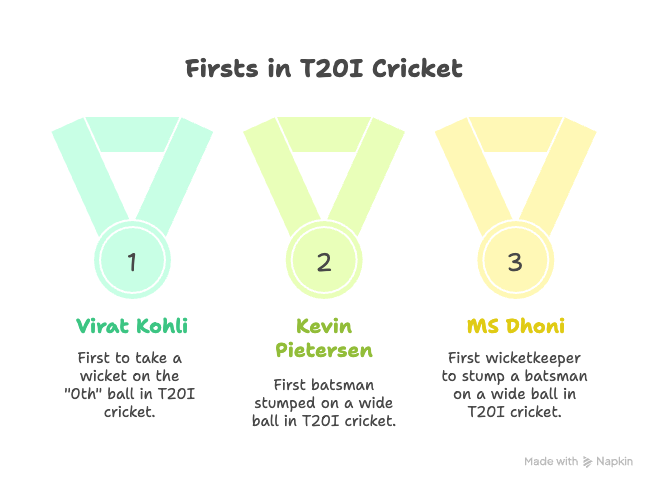Virat Kohli became the first player to take a wicket on the “0th” ball of his Twenty20 International (T20I) career. This unusual event occurred during a T20I match between India and England in 2011. Kohli’s first delivery in T20I cricket was a wide ball, but England batsman Kevin Pietersen was stumped by MS Dhoni on that very delivery.
Although it was a wide ball and therefore not a legitimate delivery, a stumping is a valid mode of dismissal even on a wide, according to the laws of cricket. This made Kohli the first and, currently, the only male cricketer to achieve a “0th ball” wicket in international cricket in any format.
Key takeaways:
- A 0th ball wicket means a dismissal before any legal delivery by that bowler.
- Very few players have ever achieved a wicket on 0th ball.
- The first such instance in men’s international cricket is credited to one specific bowler, under unusual conditions.

What Does ‘Wicket on 0th Ball’ Mean?
A “0th ball wicket” refers to a wicket taken before the bowler has bowled a legal delivery. A legal delivery excludes wides and no-balls. Therefore, if the bowler’s first attempt is a wide or a no-ball, and that extra delivery leads to some dismissal (such as stumping or run-out or some other that the laws permit), the wicket may count even though zero legal deliveries have yet occurred.
Thus, a difference must be drawn between first legal delivery dismissals and dismissals occurring on illegals or extras before any legal ball. The concept depends on the Laws of Cricket, especially on how extras are treated and which dismissals are possible off a wide or no-ball.
Historical Context of Rare Dismissals
Cricket history contains many quirky entries: dismissals by timed-out, rare run-outs, being dismissed without facing a legal ball, or getting out off the first legal ball. Those examples attract attention because they fall outside normal patterns of play. They illustrate that cricket rules, umpire decisions, and unusual tactical situations can produce bizarre outcomes.
Fans enjoy these incidents because they add character and unpredictability to the game. Statistics books often list first-ball wickets, golden ducks for batters, or odd forms of dismissals. Rare dismissals become part of quizzes, commentary, and lore.
Who was the first player to take a wicket on 0th ball in men’s international cricket?
Who, When, Where
Virat Kohli holds the distinction of being the first player to take a wicket on the 0th ball in men’s international cricket. This took place during a Twenty20 International between England and India in Manchester on August 31 2011.
How the Dismissal Happened, Step by Step
- Kohli came on to bowl in that only T20I match.
- His very first bowl was a wide delivery. That wide did not count as a legal delivery.
- During that same ball, Kevin Pietersen stepped out of his crease. MS Dhoni, keeping wicket, stumped Pietersen. Even though the delivery was wide and therefore illegal, the umpires allowed the dismissal.
- Since no legal ball had been bowled, the record shows that Kohli took the wicket on the 0th ball of his T20I bowling.
Reaction of Players and Fans
Players and commentators reacted with surprise. Kohli, known primarily for his batting, receiving bowling duties in T20Is was already of interest, but taking a wicket in such an unconventional way drew both amusement and curiosity. Fans debated whether the wicket should “count” in statistical terms; media outlets picked up the story because it illustrated an oddity in cricket. Some expressed that it was more trivia than record, yet its uniqueness ensured wide attention.
Impact and Significance of the Incident
This dismissal stands out as unusual because very rarely will a bowler dismiss someone before delivering a legal ball. It challenges intuitive understanding of “first ball,” “wicket,” and “bowling spell.” Although the International Cricket Council (ICC) does not officially create a separate category for “0th ball wickets,” the incident entered cricket trivia and record books as a curiosity.
Media coverage highlighted it as a fun fact: “Virat Kohli got a wicket without legal delivery” kind of headlines. Fans on forums asked whether any earlier bowler had done something similar and which other dismissals resembled it. Over time, journalists’ pieces, blog posts, and Q&A threads asked “who was the first player to take a wicket on the 0th ball in men’s international cricket?” and cited Kohli’s name.
Other Notable Instances of ‘0th Ball Wickets’
At present, Virat Kohli remains the only confirmed case in men’s international cricket of a wicket on the 0th ball of one’s official bowling in a format.
Some bowlers have taken wickets before bowling a legal delivery in an innings (for example, via wides or no-balls leading to dismissals), but not as their first opportunity in their international bowling career in that format. Those differ in that the bowler had already bowled earlier or delivered legal balls in other matches. Kohli’s case is unique in being the first in the format and his first legal bowling opportunity.
Rare Cricket Records Similar to This
There exist records such as first-ball wickets in Test, ODI, and T20I careers, which happen when a bowler dismisses a batsman with his first legal delivery in that format. For example, in Test cricket, Tom Horan was the first to take a wicket with his first ball.
Then there are Golden Ducks for batters (first ball faced), first-ball wickets but legal, etc. Other unusual dismissals include being run out without facing a legal delivery, or hit wicket on the first ball faced, etc. These differ from the “0th ball wicket” because they involve legal deliveries or refer to batting rather than bowling stats.
Comparatively, a wicket on the 0th ball is rarer still. It sits outside most statistical categories and is not commonly compiled in main records, leaving it more of a novelty.
How Cricket’s Rules Allow Such Incidents
Laws of Cricket permit dismissals off wides or no-balls in certain cases. For instance, a wicket-keeper stumping a batsman who steps out of his crease off a wide ball is allowed under the laws. Because that wide does not count as a legal delivery, any wicket achieved then is before any legal delivery. The umpire must rule wide first, then allow the play to continue; the keeper must effect the stumping.
Umpires monitor whether the batter is within the crease, whether any part of the batsman’s body or bat is grounded behind the popping crease; wicket-keepers must be ready. Playing conditions (e.g. the wicketkeeper’s position, the pitch itself, weather) may affect visibility or reaction time, but rules do allow such dismissals.
Fan Discussions and Trivia Value
Fans often bring up this record in quizzes, social media posts, and during commentary about odd cricket stats. It has a place among “did you know?” style facts, for its novelty more than its competitive importance. Forums sometimes ask if any bowler before Kohli had done it; others argue about whether statistics should include 0th ball wickets distinctly.
Because it is so rare, people often cite the wicket on the 0th ball alongside Golden Ducks, first-ball wickets, and unusual dismissals in quirky statistical records. It reminds fans that the sport remains unpredictable and capable of surprises.
Final Take
Virat Kohli was the first player to take a wicket on the 0th ball in men’s international cricket during the T20I match between India and England at Manchester on 31 August 2011. His first “bowling attempt”, which was a wide, led to Kevin Pietersen being stumped by MS Dhoni, before Kohli had bowled any legal delivery. That event remains unique and fascinating.
Cricket’s sporting value lies not just in centuries or five-wicket hauls, but in these odd moments that break conventions. Moments such as a wicket on the 0th ball continue to fascinate fans because they show that no matter how well one knows the game, surprises persist.

